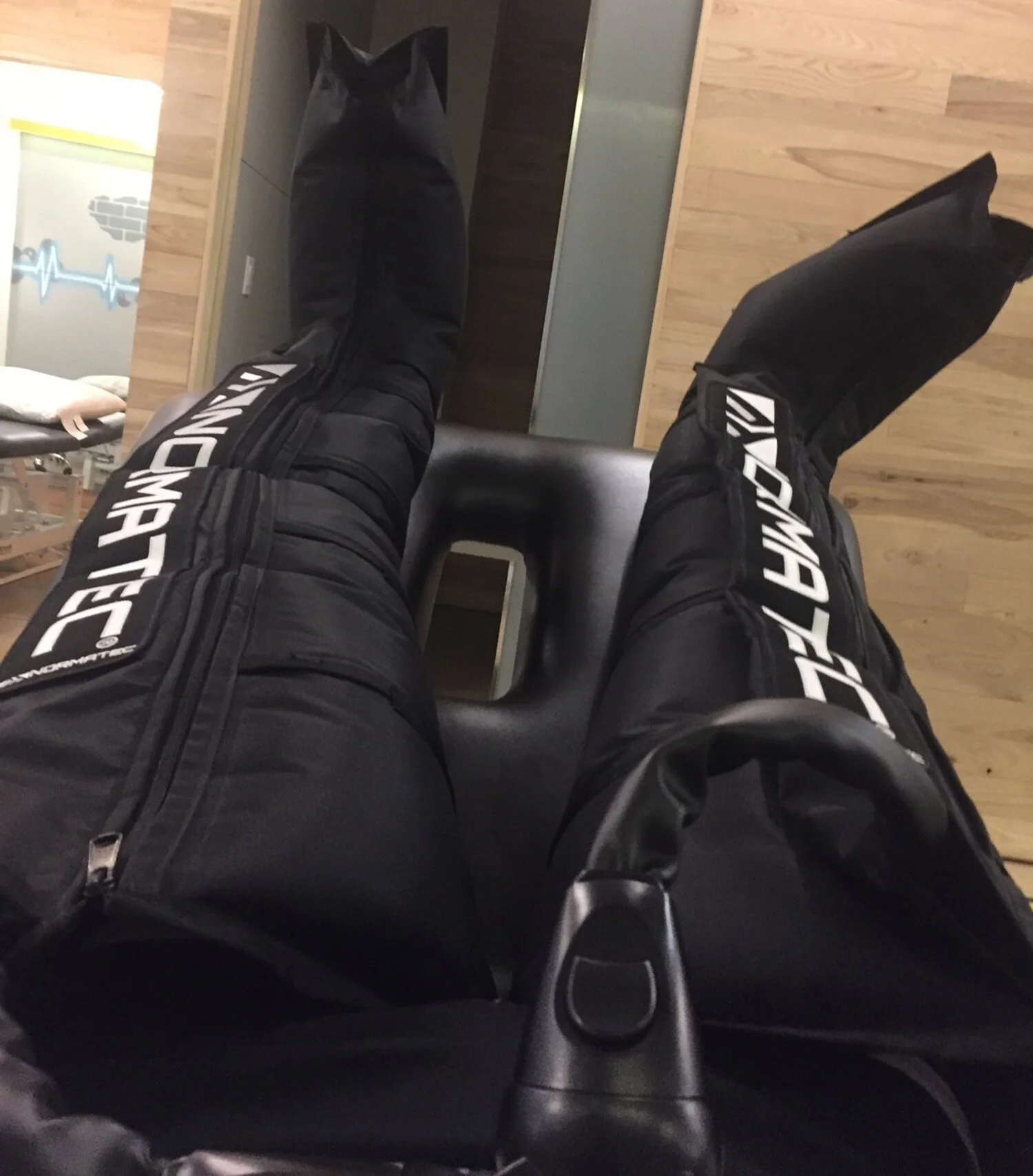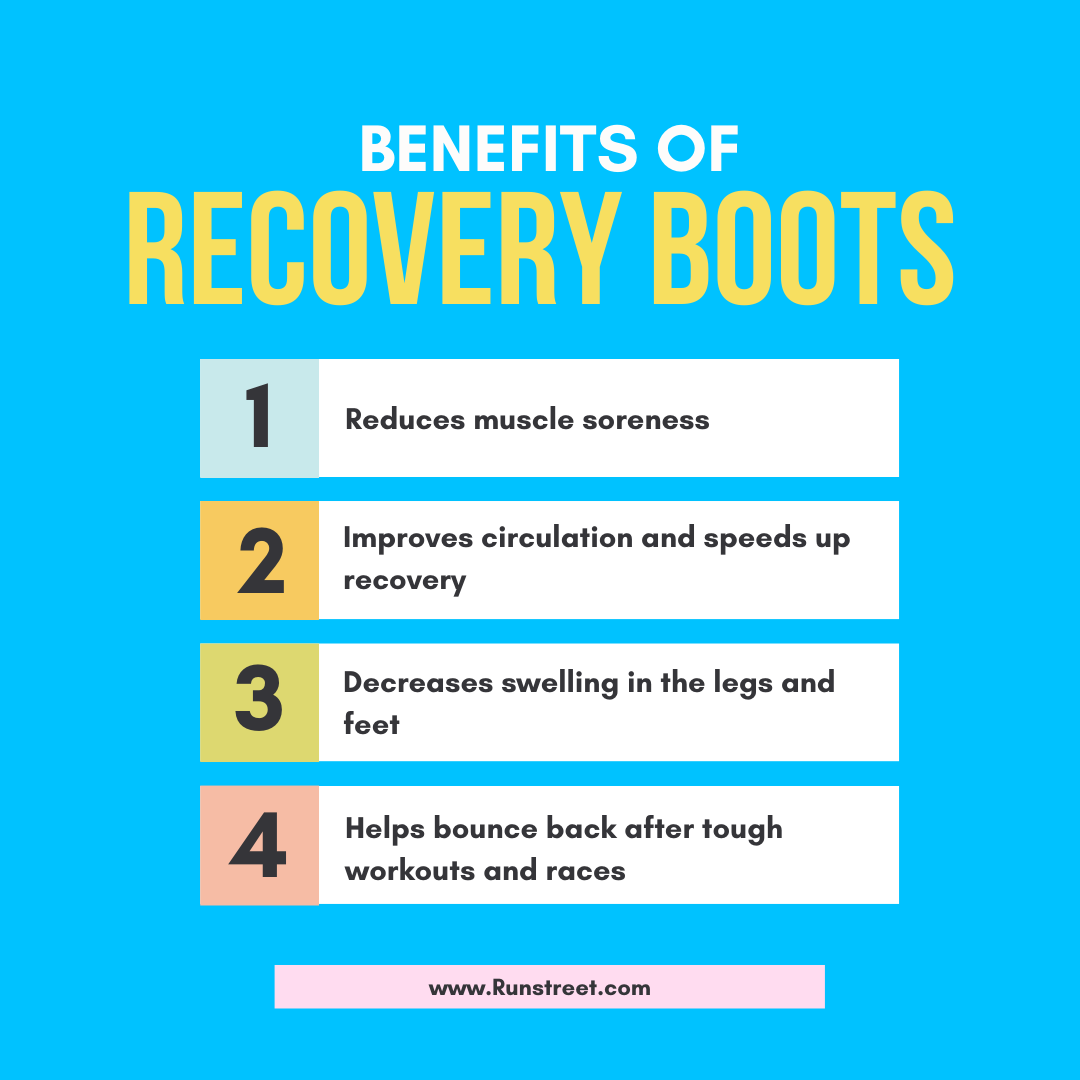Compression Boots: Benefits and Tips for Runners
Compression boots are a useful tool that can help boost your running recovery. Are you training for something this year? With all the training hours you’re putting in, it's essential to match that with adequate recovery time. From getting a solid night’s sleep to trying a cold shower or even an ice plunge, to foam rolling, and eating protein-rich meals, there are plenty of ways to prioritize recovery time. Another great option that is also a medical-grade recovery device is compression boots.
Have you tried these funky-looking devices?! While akin to the 2000s moon-boot trend, compression - or recovery - boots offer your legs a gentle air massage, designed to offer your legs a sense of relaxation, reduce soreness and increase blood flow. Compression therapy can speed up your workout recovery and help with the healing process when you're injured.
You may be more familiar with—and perhaps have even tried—other types of compression clothing such as compression socks, popularized for running recovery after long races, long-haul flights, and for pregnant people to help with circulation.
Runstreet founder Marnie using compression boots at Custom Performance in NYC.
Compression boots work similarly and are arguably even better at increasing blood flow and circulation in the legs. Legendary athletes ranging from LeBron James to Simone Biles have used them regularly to boost muscle recovery.
Disclaimer: When you buy through our links, we may earn a commission - at no extra expense to you. We only do this for products we have tried or come highly recommended. Learn more.
How Do Compression Boots Work?
After putting on recovery boots and zipping them up, they will cover the majority of your legs. Some boots are more lightweight with less coverage while others encircle your entire leg. The boots use dynamic air compression to start to inflate and deflate, creating pressure at various points across the leg, starting at the feet and working their way up, increasing the blood flow.
This movement removes metabolic and lymphatic waste from your leg muscles. This process typically takes an entire day naturally, so using recovery boots speeds up the process, pushing the lymphatic waste up your legs and into your lymph nodes. This somewhat similar to a lymphatic massage.
Types of Recovery Boots
Compression boots have different modes and pressure settings. Depending on the model and type of your boots, some get plugged in and do the pumping automatically, while you sit back and relax. Others are wire-free and rely on battery life. Some boots require you to squeeze the pump yourself at the pressure you desire.
Many compression devices now offer app connectivity as well for convenience. You can relax in your boots and scroll through your phone, watch a movie, read a book, chat with others, or even take a quick power nap.
How Can Compression Boots Help Runners and Athletes?
Recovery boots flush out some of the toxins that can build up throughout your training and exercise routine, aiding the body to return to a healthy state with oxygenated blood returning to the legs, boosting recovery after working out. It is best to wear compression boots for around 15 to 30 minutes each session, though each boot will let you know the most beneficial time frames.
You can use your recovery boots can anytime! It doesn't have to be directly after a workout - you can boot up morning, noon, and night to increase circulation and enjoy the recovery benefits for your lower legs.
For athletes and runners, compression boots can support your body with the following:
Can reduce muscle soreness – including delayed onset muscle soreness.
Support in decreasing swelling in the feet and legs after long, difficult runs.
Speed up recovery time and performance.
Chance to slow down and enjoy a relaxing, quiet moment.
If you’d like to try out recovery boots, many physical therapists and sports rehab centers have the boots and offer recovery services.
How To Pick the Best Compression Boots
If you’ve tried recovery boots and love them, you may be ready to invest in a pair for yourself. There are several considerations to think about when picking compression boots, including:
Photo by Marques Jackson Photography.
Sizing and fit: Most compression boots on the market come in a wide range of sizes, and just like running shoes, the fit is key. If the boots are too big, they won't massage the legs deep enough, and if they fit too small, they can be very painful and uncomfortable. Depending on the brand, check out the compression chart, to determine what size will work based on inseam length and height.
Boots chambers: When looking for boots, you’ll want ones with the most air chambers. At the least, compression boots should have four separate air chambers for the best possible massage.
Cleanability: As the boots get warm, they are likely to become sweaty and a little smelly after multiple uses. So, look for some boots that can be easily taken apart so they can be cleaned.
Settings: There should be a nice amount of options and settings on your boots so that you can alter the levels of pressure and isolation. A solid option to look for is at least three compression levels.
Coverage: Full-coverage recovery boots will give your legs the maximum benefits but if you want to target certain areas, there are calf recovery boots that target your calves that are especially helpful for tight calves and calf injuries.
Brands: Some brands are well-known and more trusted than others. Be wary of super-cheap recovery boots online as they may not be as effective as other options. Normatec boots by Hyperice are a popular brand for recovery boots that PTs often use.
Portable Recovery: If you’re interested in full compression that’s portable, the Normatec Go are recovery sleeves for your legs that you can wear on air planes and on the go. These high-tech slips are TSA-approved, combat fluid retention and promote recovery. One of the main differences with Normatec Go and regular Normatec compression boots is that the sleeves do not need to be plugged in. The sleeves are especially helpful for sore calves.
Related Post: Calf Pain When Running: Common Causes and What to Do
What, If Any, Are The Negatives To Compression Boots?
One drawback of recovery boots would be the fact that the average person would need to save up for a little while to get their own recovery boots, as they cost anywhere from $500 and up. The Normatec Go, however, are less expensive than full body compression boots and offer a wireless design.
Another potential negative is the learning curve. This is something that can easily be overcome with some training, but it certainly exists. Using the boots correctly may be easy for a physical therapist, but the rest of us will need to learn how to operate any attachments and adjust levels of compression.
Better Recovery
Recovery after a big workout is vital and is truly just as important as the workout itself. There really is no greater feeling than indulging in great relaxation and recovery, including compression boots to massage away the discomfort and speed up your muscle recovery. For more ways to boost your recovery, see our 20 Tips for Better Workout Recovery.
Have you tried compression boots? Comment below or tag @Runstreet on Instagram to share your training and get cheered on. Happy running to you, and happy recovering!
Related Posts: 10 Common Running Injuries, 8 Tips for Muscle Recovery
Marissa Del Mistro is a writer, editor, and always on the hunt for the perfect workout. Marissa absolutely loves trail running, dancing, and cycling. When she’s not writing, Marissa loves cooking, podcasts, traveling, and exploring her home in the beautiful unceded Coast Salish Territory of the Lekwungen and W̱SÁNEĆ nations.




